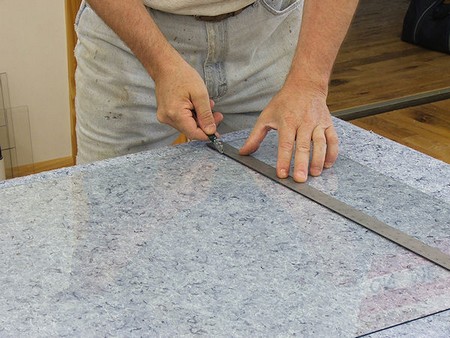The key to successful working with glass is confidence. If you know what you are doing and treat glass with the proper respect, there should be no problems; if you are careless or uncertain, you will break it.
Normally, it makes sense to get a glass merchant to cut glass to the exact size when you buy it and perhaps to cut any holes and smooth the edges, but there will still be occasions when you will need to know how to cut a straight line, how to cut a circle, how to drill holes and how to finish edges. It may be worth practising on a piece of waste glass.

Glass is cut by scoring a line along the surface with a glass cutter and then applying pressure on either side of the score line to make a clean break. The glass itself should be clean and free from cracks and notches and the surface it is cut on should be flat, even and padded -with felt, old carpet or layers of newspaper. Patterned glass should always be cut on the flat side.
Most glass cutters have a small hardened steel wheel to make the score – some have six wheels, which are used in turn as they go blunt. Before use, a glass cutter should be ‘wetted’ with white spirit or paraffin. Mark the cutting line with a felt pen – do not use a waxed pencil.
The line should be scored with one continuous firm stroke, pulling the cutter towards you. The cutter is held in the hand rather like a pencil and at an angle of about 60 degrees to the glass. It is essential to use a straight-edge or T-square to keep the line straight. Too much pressure can cause the glass to flake.
The glass can now be broken – by placing a straight wooden lath or other straight edge under the score and applying light but firm pressure on either side of the score. Another method is to tap the underside of the score lightly with the back of the glass cutter and snap the glass apart by holding it at one edge on either side of the score and flexing downwards. This method is particularly useful when cutting only a thin strip off a pane. With a very thin strip, it is necessary to nibble the strip off after making the score using pliers, pincers or the slots in the handles of most glass cutters. These slots – usually for two or three different thicknesses of glass – are known as a breaker rack.
After the glass has been broken, the edge can be smoothed with the smooth side of an oilstone moistened with water. Fine glass paper can also be used, but it must be wrapped around a support block for safety. Edges can also be smoothed with a breaker rack.